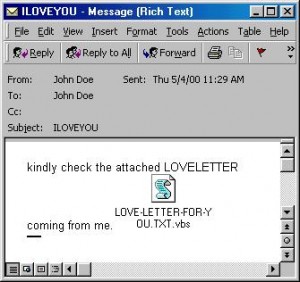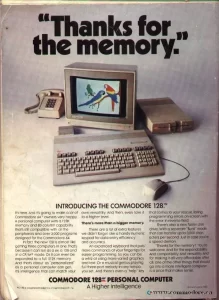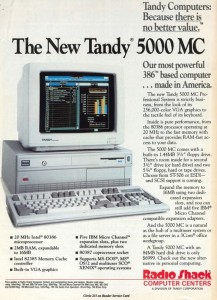Computers
IBM 704 Introduced
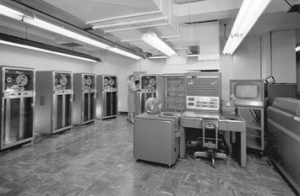
IBM announces the IBM 704 Data Processing System, the world’s first mass produced computer to feature floating point arithmetic hardware. Besides this ultra-geeky distinction, the IBM 704 will leave its mark in computer history before it is discontinued on April 7, 1960. Both the FORTRAN and LISP programming languages were first developed for the IBM 704, as well as the first music application, MUSIC. Physicist John Larry Kelly, Jr. of Bell Labs will synthesize speech for the first time in history on an IBM 704. Not bad for a mainframe.
Wolfenstein 3D Blasts Onto Scene
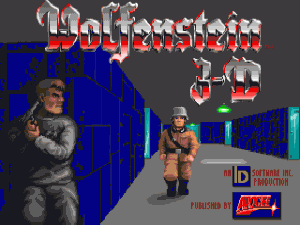
id Software Inc. releases the game Wolfenstein 3D, the original first person shooter game for DOS computers. While it was technically not the first FPS in video game history, Wolfenstein 3D was the game that definitively popularized the genre. Using the shareware model to freely distribute the first of three episodes with the ability to purchase the next two episodes, the game became an instant success, selling 200,000 copies in the first year. The success of Wolfenstein 3D made id Software a household name in the gaming world. They followed up in the next year with the massively popular Doom, which cemented the first person shooter gaming genre and the rest is history.
In addition to being credited with launching the first person shooter genre, Wolfenstein 3D is also widely regarded as proving the viability of and popularizing the shareware distribution model. The game was ported to many different platforms over the years and is still available for purchase to play today.
Love Stinks
May 4, 2000
The Love Letter computer virus, aka the “ILOVEYOU” bug, spreads to personal computers running Windows around the world in just six hours. Spreading through e-mail, the virus entices victims to open the message with the subject of “ILOVEYOU”. About 2.5 to 3 million PCs will become infected. The cost of system downtime is later estimated at $8.7 billion. It is thought to be the fastest-moving and most widespread virus in history.
Commodore Assets Purchased out of Bankruptcy
German company Escom AG purchases the rights to the name, patents, and intellectual property of Commodore Electronics, which had declared bankruptcy in 1994. Commodore was a pioneer in the personal computing industry, holding some impressive records such as having the best selling computer in history with the Commodore 64, which The Guinness Book of Records estimates about 30 million units were sold over the course of 10 years from 1982 to 1992, the first computer company to have over 50% of the home PC market, and the first company to make over $1 billion in sales. They also created some of the most innovative computers in the early PC market such as the first multimedia computer, the Amiga. Unfortunately for Commodore as it was with many early PC companies, the juggernaut of the IBM-compatible PC combined with poor management was their ultimate undoing.
Dell Founded

Dell Computer Corporation is founded by Michael Dell, running the direct-to-order PC company from his dorm room. Using this innovative direct-to-order model, Dell, Inc. eventually became the largest manufacturer of PCs in the world for many years. Through ups and downs, it is still currently in the top 3 as of 2022 in market share for personal computers.
Microsoft Acts Mousey
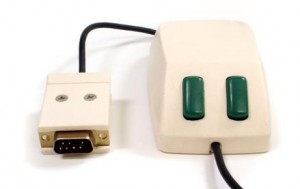
Microsoft introduces the Microsoft Mouse for IBM and IBM-compatible PCs. The mouse featured two green buttons and is available by itself or will later be bundled with the new Microsoft Word software, which Microsoft would release in September. Because of the green buttons, the mouse was nicknamed the “Green-Eyed Mouse”, which may have been a fitting name given it’s similarity to the Shakesperian phrase “green-eyed monster” to describe jealously. It was no secret Bill Gates was very envious of what Apple was creating with the Lisa and later Macintosh computers and their mouse-driven interfaces. Microsoft will manufacture nearly one hundred thousand units of their first mouse, but will only sell five thousand before introducing a second, more popular version in 1985.
Microsoft would go on to create a very successful line of mice and other computing peripherals over the years, but almost ironically Microsoft announced in April of 2023, nearly 40 years later, that they would end the production of Microsoft-branded peripherals and focus on their Surface-branded peripherals. This came months after Microsoft announced a 30% year-over-year drop in revenue from devices, cut 10,000 jobs, and announced “changes to their hardware portfolio”.
Commercial Computer Mouse Introduced
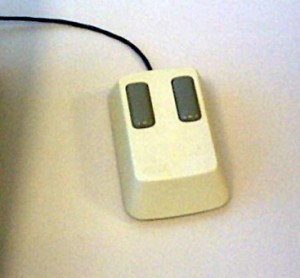
Xerox introduces the Xerox 8010 Star Information System, the first commercial system utilizing a computer mouse, among other now commonplace technologies. The 8010 was geared towards business and was not a commercial success, therefore the mouse remained in relative obscurity until the Apple Lisa, but more prominently the Apple Macintosh, brought the mouse into the mainstream.
Chernobyl Virus Melts Down PCs
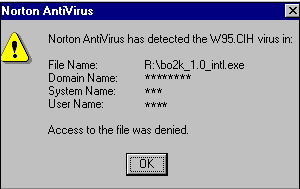
The first known virus to target the flash BIOS of a PC, the CIH/Chernobyl Virus triggers its payload on this day, erasing hard drives and disabling PCs primarily in Asia and Europe. One of the most destructive viruses in history, it is estimated that 60 billion PCs were infected worldwide causing $1 Billion in damages.
The virus had been created exactly one year earlier on April 26, 1998 by Taiwanese student Chen Ing-hau and set to trigger its destructive payload exactly one year later. It began to spread in the wild and was first discovered in June of 1998, given the name CIH due to the author’s initials discovered in the virus code. From this time forward it was reported that a variety of companies accidentally distributed the virus through various downloads, updates, and CDs. When the virus triggered on this date it just happened to coincide with the date of the Chernobyl disaster in 1986 and therefore the press began to call it the Chernobyl virus, even though there has never been any evidence to show that this date was chosen intentionally for this reason.
IBM Licenses PC Patents
The Tandy Corporation holds a press conference to announce plans to build clones of IBM’s PS/2 system computers. The conference comes soon after IBM’s announcement that it would license patents on key PC technologies. IBM made this decision as they realized they were losing control of the “IBM-compatible” PC market and could make more money licensing the technologies. Within five years, IBM clones will become more popular than the original IBM machines themselves. Eventually IBM would leave the PC manufacturing business altogether, selling their PC division to Lenovo in 2005.
Moore’s Law Published

Electronics magazine publishes an article by Gordon Moore, head of research and development for Fairchild Semiconductor and future co-founder of Intel, on the future of semiconductor components. In the article, Moore predicts that transistor density on integrated circuits will double every eighteen months for “at least” the next ten years. This theory will eventually come to be known as Moore’s Law and has largely held true to this day. Controversy exists over whether Moore’s Law remains applicable, however time will tell just how long Moore’s Law will continue to remain true.

